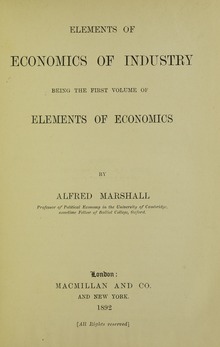Alfred Marshall
Alfred Marshall (born July 26, 1842 in Bermondsey near London , † July 13, 1924 in Cambridge ) was one of the most influential economists of his time. He is a representative of the Cambridge School of Neoclassicism . His main contribution is the expansion of the microeconomic partial analysis . The supply and demand diagram of the market diagram , which he popularized, are still standard in economics .
Life
Marshall suffered from a very strict father who would have liked to see him as a priest . He studied at St John's College , Cambridge , with the financial help of his uncle . It was there that he received his first professorship, which he had to give up in 1877 because he married one of his students, which violated the rules of professional conduct.
Like many Brits at the time, Marshall was an enthusiastic alpinist and verifiably was the first to climb the Karlesspitze in the Ötztal Alps with two Austrian mountaineers .
In 1883 he was called back to Cambridge. There he succeeded in 1903 in establishing economics as an independent subject. Among his students there was John Maynard Keynes . In 1908 he retired and was succeeded by his pupil Arthur Cecil Pigou . In 1916 Marshall, a member of the British Academy since 1902 , was elected to the American Academy of Arts and Sciences .
In his book Principles of Economics , published in 1890 , which was for a long time a leader in Great Britain, he presented many theories of his time in a coherent framework for the first time and developed many analytical tools that are now standard in economics .
He popularized the presentation of the theory of demand and supply developed by Karl Heinrich Rau in the form of supply and demand curves (see source Wolfgang Borgstedte below), in which he also implemented the principle of decreasing marginal utility for the first time . He compared the supply and demand curves with the blades of a pair of scissors . Therefore, one speaks of the shear theorem if one assumes a price-quantity diagram with an increasing supply and decreasing demand curve. Marshall coined the term consumer surplus as the area under the demand curve (falling) bounded by the (underlying) price line; Here the concept of producer surplus implies the area between the supply curve and the price line (above). The equilibrium price in Marshall's standard diagram means that price-quantity equilibrium that optimally corresponds to the current needs of supplier (s) and customer (s). All imbalance situations above and below the equilibrium price mean diverging preferences . An upward shift in the demand curve means either a preference change on the demand side in the sense of higher volume requirements (additional purchases are made) or new customers enter. A downward shift in the curve has the opposite effect, and the same statements can of course be interpreted analogously into the supply curve (see also pricing ).
Abba P. Lerner later developed a Marshall formula . It has since been known as the Marshall Lerner condition . Marshall also introduced the “ ceteris paribus ” clause as an instrument.
Since Marshall, contrary to the current norm, transferred the price as an independent variable in the vertical direction, this reversed form of the axis designation is traditionally continued in economics today.
Publications
- Principles of Economics , Macmillan, London 1890
- Elements of Economics of Industry , Macmillan, London 1892
literature
- Rolf Hüpen: The Marshall Rules ( Memento from March 31, 2005 in the Internet Archive ) . In: Wirtschaftswwissenschaftliches Studium (WiSt), 17th year, issue 5 (May 1988), pp. 243–246.
- In his work “Volkswirtschaftslehre” (Düsseldorf 1977), Wolfgang Borgstede points out that Karl Heinrich Rau in his textbook on political economy “[brought] very original and didactically brilliant presentation methods. He worked decades before Alfred Marshall with the geometric form of representation of supply and demand curves that is still common today. However, it was not well received in Germany. He is therefore generally not considered to be their inventor. This is common. Not the person who first developed an idea is usually considered to be the discoverer, but rather the person who penetrated with the idea. "
Web links
- Literature by and about Alfred Marshall in the catalog of the German National Library
- Works by and about Alfred Marshall in the German Digital Library
- Alfred Marshall in the catalog of the ZBW - Leibniz Information Center for Economics (ZBW)
| personal data | |
|---|---|
| SURNAME | Marshall, Alfred |
| BRIEF DESCRIPTION | British economist |
| DATE OF BIRTH | July 26, 1842 |
| PLACE OF BIRTH | Bermondsey (London) |
| DATE OF DEATH | July 13, 1924 |
| Place of death | Cambridge |


